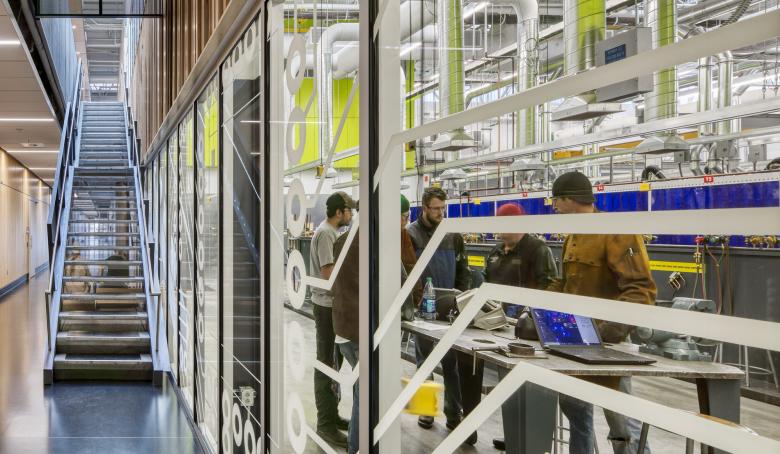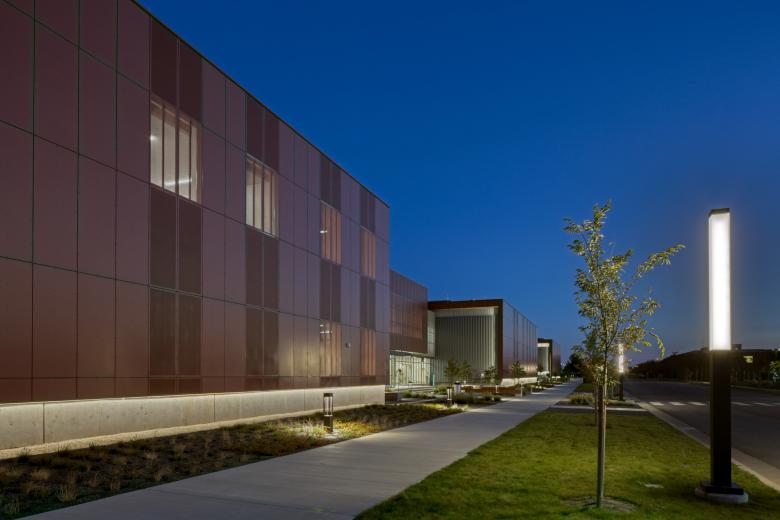Westpointe Workforce Training and Education Center
Salt Lake City, USA
- Architects
- SRG Partnership
- Location
- 1060 N. Flyer Way, 84116 Salt Lake City, USA
- Year
- 2017
- Client
- Salt Lake Community College
- Team
- Jane Hendricks, Uwe Bergk, Jennifer Youngblood, Leslie Boll
- Architect of Record
- ajc architects
- Contractor
- Big-D Construction
- Civil Engineer
- Meridian Engineering, Inc.
- Structural Engineer
- Reaveley Engineers & Associates
- Mechanical & Plumbing Engineer and Energy Modelling
- Colvin Engineering Associates
- Electrical Engineer & AV
- Spectrum Engineers, Inc.
- Landscape
- Landmark Design
- Envelope Consultant
- Intertek – Architectural Testing Inc.
The Westpointe Workforce Training & Education Center (WWTEC) at Salt Lake Community College (SLCC) is a technically sophisticated facility for hands-on learning that supports the community’s training needs in a flexible, high-quality space. Located in an underserved area of Salt Lake Valley, the adaptable WWTEC aligns with SLCC’s mission as the area’s primary post-secondary provider of technical workforce education, addressing a growing shortage in skills-based workforce.
The facility brings together technical education in advanced manufacturing trades active in the
Salt Lake Valley, including Composites, Plastics, Machining, Welding, Electronics, Diesel Technology and CDL Truck Driving. Collaborative lab, classroom and shop spaces based on real-world working environments help ensure students are well-equipped to enter Utah’s growing STEM-based industries.
The WWTEC sits on a highly visible site immediately west of I-215, creating an opportunity for the building to express the dynamic activities held within, as well as the values of the College. The building’s east façade became an opportunity for SLCC branding, while the facility’s form ended up being 121,000sf and more than 600 feet long. The magnitude of the WWTEC was addressed in design by breaking up the mass through form and materials, accommodating the human scale with a more approachable, pedestrian-friendly environment for students and faculty. Varied solid/void relationships were also employed to break up the mass, with a strong inside/outside connection between public spaces.
The exterior massing demonstrates the WWTEC’s function and interior program, while themes of visual transparency within put training on display to motivate and inspire students. High-bay lab spaces are organized along one side of a linear spine, with two levels of classrooms and support spaces on the spine’s street side. Envisioned as a healthy, vibrant learning environment for students and faculty to encourage learning, the interiors feature higher ceilings, abundant indoor-outdoor connections, natural daylight, and passive learning spaces in which users can interact and socialize. The interior program separates the industrial scale of hands-on shop space from the human scale of general academic classrooms and open study areas.
The facility offers the highest possible levels of life safety, security, daylighting, clean air, and the efficient use of energy and water in support of all activities held within. In pursuit of net-zero electricity usage, a 3,520-panel, roof-mounted solar array provides much of the Center’s electrical needs. Furthermore, 28 skylights and continuous clerestories bring in ample natural light to boost cognition and productivity.
The WWTEC gives students pursuing technical careers a unique one-stop education center
in preparation for the workforce, serving the College and its community for years to come.
Related Projects
Magazine
-
Winners of the 5th Simon Architecture Prize
1 week ago
-
2024, The Year in …
1 week ago
-
Raising the (White) Bar
1 week ago
-
Architects Building Laws
2 weeks ago

















